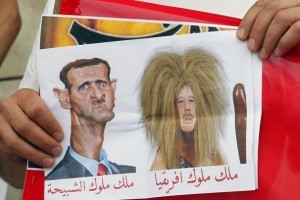 Syrian riot police clashed with protesters in Damascus on Friday, firing tear gas and beating people with batons, while other demonstrations erupted across the country in a marked expansion of a month-long wave of unrest, witnesses said.
Syrian riot police clashed with protesters in Damascus on Friday, firing tear gas and beating people with batons, while other demonstrations erupted across the country in a marked expansion of a month-long wave of unrest, witnesses said.
Shouting, “Freedom! Freedom!” and “National unity, Muslims and Christians,” a large crowd marched toward al-Abbasiyeen Square in northern Damascus, where police were blocking access late in the afternoon, witnesses said.
It was the largest day of demonstrations since the uprising here began in mid-March, according to Syrian activists reached via the Skype Internet service. Activists said up to 100,000 people joined the Damascus march, which began in Douma, outside the city, and picked up more participants as it passed through Harasta, Irbin, Zamalka and Jobar, en route to the capital.
It was impossible to independently confirm the number of protesters because foreign news media have been restricted from reporting in Syria.
“There was a lot of tear gas,” said a 35-year-old engineer who took part in the Damascus protest and said he was beaten on his legs with batons. “Many people were bleeding around the area, but many were insisting and trying to go to the square.”
By late afternoon, it was unclear whether protesters had been able to reach the square. But “just to arrive in that area was a huge achievement, because we reached Damascus,” the engineer said.
Protests also took place Friday in other cities across the country, including Homs, Latakia, Daraa, Baniyas, and Jassan, as well as in Syria’s Kurdish region, according to activists, who said government forces fired at protesters in Latakia, a city on the coast.
The movement in Syria has been marked by swelling protests and fierce crackdowns by state security forces, who have opened fire on crowds and arrested people en masse.
In recent days, in the most recent of a string of apparent attempts to placate protesters, the government released many of the detainees, and on Thursday it announced a new cabinet.
Friday, the Muslim day of prayer, had been widely anticipated as an indicator of whether the opposition movement would subside or continue to gain steam.
“Today is the biggest ever since it started,” said Razan Zaitouneh, a human rights activist and lawyer who was near the square during the protests. “It means that people didn’t respond to the violence of the authorities. The authorities were trying to make people scared, but people responded in the opposite way, by going out in larger numbers.”
However, it is unclear if those numbers are large enough to tip the balance in favor of protesters, said Rami Khouri, director of the Issam Fares Institute for Public Policy and International Affairs at the American University of Beirut.
“There’s a serious issue for the regime in terms of people demonstrating throughout the country, but who’s doing it and what’s the extent of it is very hard to know,” he said. But, he added, “The longer it goes, the more difficult it is for the regime to calm things down.”
Whereas earlier protests had called for greater freedoms and the lifting of a decades-long emergency law, more recent protests, including those in Damascus on Friday, have increasingly called for the ouster of President Bashar al-Assad, 45.
Assad’s government, considered one of the most repressive in the Middle East, has close ties with Iran, and on Thursday the Obama administration accused Iran of helping Syria attempt to stamp out the recent protests, a charge Syrian officials denied.
A Human Rights Watch report issued Friday said that Syrian security and intelligence services have arrested and tortured hundreds of protesters around the country since anti-government demonstrations began last month. According to rights groups, 200 people have died so far in the the protests.
Syria’s state-run SANA news agency reported that one soldier was killed and another wounded Friday morning in the port city of Baniyas, the site of earlier demonstrations this week.
As the sun set, security forces were raiding houses around Damascus’s al-Abbasiyeen Square, Zaitouneh said.
Photo: Cartoon reads : Libyan leader Moammar Gaddafi – right ( King of the African kings ) Syrian president Bashar al Assad ( king of exaggeration)
Leave a Reply
You must be logged in to post a comment.